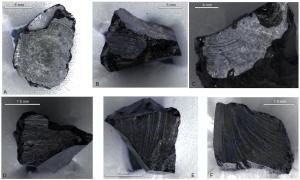
PLOS—Middle Eastern Bitumen, a rare, tar-like material, is present in the seventh century ship buried at Sutton Hoo, according to a study* published in the open-access journal PLOS ONE on November 30, 2016 by Pauline Burger and colleagues from the British Museum, UK and the University of Aberdeen.
The seventh century ship found within a burial mound at Sutton Hoo, UK was first excavated in 1939 and is known for the spectacular treasure it contained including jewellery, silverware, coins, and ceremonial armour. The site is thought to be an example of the European ship-burial rites of the time, and also includes a burial chamber where a corpse was likely laid. Fragments of black organic material found in this chamber were originally identified as locally-produced ‘Stockholm Tar’ and linked to repair and maintenance of the ship. The authors of the present study re-evaluated these previously-identified samples, as well as other tar-like materials found at the site, using imaging techniques and isotopic analysis and found the samples had been originally misidentified.
_______________________________________
RTI images of surface morphology on fragments from 1939,1010.251. Upper images (A, B and C) show concentric rings suggestive of working or worked imprints; lower images show natural fracture surface on the same fragments (D and E) and on a reference specimen of bitumen (F). Credit: Burger et al (2016)
____________________________________________________
By comparing the samples from Sutton Hoo to various reference materials, the researchers’ analysis revealed that the previously-identified ‘Stockholm Tar’ lumps actually displayed the molecular and isotopic characteristics of archaeological bitumen, and specifically bitumen from the Middle East rather than from a local British source. Archaeological finds of bitumen from this period in Britain are extremely rare and the authors state that this finding is the first material evidence for trading of Middle Eastern bitumen northwards into the British Isles.
While the original form and purpose of the bitumen could not be discerned from the remaining fragments, the authors suggest that it may have been included deliberately in the burial chamber, possibly the remaining components of ornamental objects adorning the grave, or perhaps included as a prestigious raw material.
Article Source: PLOS news release
____________________________________________________
*Burger P, Stacey RJ, Bowden SA, Hacke M, Parnell J (2016) Identification, Geochemical Characterisation and Significance of Bitumen among the Grave Goods of the 7th Century Mound 1 Ship-Burial at Sutton Hoo (Suffolk, UK). PLoS ONE 11(11): e0166276. doi:10.1371/journal.pone.0166276
____________________________________________________
Subscribe to Popular Archaeology Premium. Available on all laptops and mobile devices, and still the industry’s best value at only $9.00 annually.
___________________________________________
Travel and learn with Far Horizons.
____________________________________________
This richly illustrated issue includes the following stories: Recent findings shedding new light on the whereabouts of the remains of Philip of Macedon, father of Alexander the Great; how an archaeologist-sculptor is bringing bones of the dead back to life; archaeologists uncovering town life at the dawn of civilization; an exclusive interview with internationally acclaimed archaeologist James M. Adovasio about what makes the Meadowcroft Rockshelter prominent in the ongoing search for the first Americans; what archaeologists are finding at the site of the ancient city of Gath, the home town of the biblical Philistine giant, Goliath; and how scientists are redrawing the picture of human evolution in Europe. Find it on Amazon.com.







